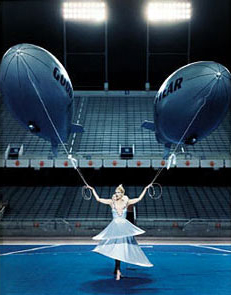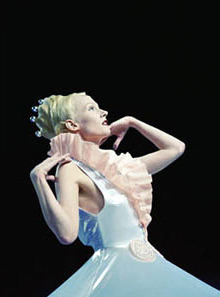Cremaster 1 (Matthew Barney, 1995)
 To thematically, if not chronologically, kick off his
five-film Cremaster cycle, sculptor/filmmaker Matthew Barney made Cremaster
1, a forty-odd minute long look in, above, under, and around a complex
visual metaphor. It’s the start of the series that, among other things,
metaphorically chronicles the biological process from the sexually
undifferentiated state that exists at conception to the full realization of the
sexual identity, which occurs with the maturation of the gonads. Because this is
the first entry in that cycle, representing the time that exists between
conception and the determination of sexual identity, it begins in an idyllic
state. It is the only segment of the series that does not feature Barney in any
of the roles, instead attempting to convey the state of gender neutrality by
featuring a cast composed entirely of similar looking, platinum blonde women.
They seem to represent the chromosomal pool of X chromosomes before the entry of
a Y, and the definition of maleness, became a possibility.
To thematically, if not chronologically, kick off his
five-film Cremaster cycle, sculptor/filmmaker Matthew Barney made Cremaster
1, a forty-odd minute long look in, above, under, and around a complex
visual metaphor. It’s the start of the series that, among other things,
metaphorically chronicles the biological process from the sexually
undifferentiated state that exists at conception to the full realization of the
sexual identity, which occurs with the maturation of the gonads. Because this is
the first entry in that cycle, representing the time that exists between
conception and the determination of sexual identity, it begins in an idyllic
state. It is the only segment of the series that does not feature Barney in any
of the roles, instead attempting to convey the state of gender neutrality by
featuring a cast composed entirely of similar looking, platinum blonde women.
They seem to represent the chromosomal pool of X chromosomes before the entry of
a Y, and the definition of maleness, became a possibility.
Set on and above a football field where a gaggle of women
perform elaborate, Busby Berkeley-style dancing routines, seemingly at the whim
of a controlling figure who floats in a pair of blimps above, Cremaster
1 acts as an introduction to the heavily coded symbolism that Barney
employs. The environment is a macrocosmic system that represents the first
stirrings of an organism’s development. The blimps, each emblazoned with
the Goodyear logo, represent the gonads (not yet either male or female at this
time, they could become either testicles or ovaries). The girls on the field
below seem to stand in for the chromosomes, their dance an organizing cellular
process. Within each blimp, there are similar contents: a table laid out with
grapes (red grapes in one blimp, green in the other), a sculpture that resembles
the gonadal structure (either of female ovaries and fallopian tubes or the male
testes and vas deferens), several nearly identical flight attendants, and, most
significantly, a woman under each table who seems increasingly in control of the
process.
 It’s the development of this woman under the tables,
referred to in the credits as Goodyear, which gives Cremaster 1 what little narrative it has. Starting from a reluctant
fetal position, she unfurls within the perfectly white, cloistered womb that
exists under the tablecloth and begins using the handholds and footholds on the
underside of the table in the first representation of ascension in the series.
Using her hairpins, she burrows through the table above her and begins to pilfer
the grapes on the tables, which then pass through her foot to the floor below.
As this occurs, Barney cuts to the view of the football field below, showing the
anonymous dancing girls as they begin moving in symmetrical formations that are
initially obscure, but are revealed to correspond to the layouts of the grapes
on the floor of the blimp. Unlike the passive flight attendants who observer
their environment without much constructive interaction, Goodyear, who seems to
be a surrogate for the artist, begins to figure out the workings of the world
around her.
It’s the development of this woman under the tables,
referred to in the credits as Goodyear, which gives Cremaster 1 what little narrative it has. Starting from a reluctant
fetal position, she unfurls within the perfectly white, cloistered womb that
exists under the tablecloth and begins using the handholds and footholds on the
underside of the table in the first representation of ascension in the series.
Using her hairpins, she burrows through the table above her and begins to pilfer
the grapes on the tables, which then pass through her foot to the floor below.
As this occurs, Barney cuts to the view of the football field below, showing the
anonymous dancing girls as they begin moving in symmetrical formations that are
initially obscure, but are revealed to correspond to the layouts of the grapes
on the floor of the blimp. Unlike the passive flight attendants who observer
their environment without much constructive interaction, Goodyear, who seems to
be a surrogate for the artist, begins to figure out the workings of the world
around her.
Initially, the grapes fall to arrange themselves, but then
Goodyear observes and begins to control them, and the dancers below. Her
manipulations of grapes start out accidental, but they grow more intentional as
she gains confidence in her surroundings. When she reaches out to rotate the
sculpture, in a gesture of sexual definition, she gets a gob of white goo on her
hand, which she immediately incorporates into her “sculpture” by dabbing it
onto the tops of the grapes. This gesture shows how the artist’s experience
informs the work they created, but also seems to comment on Barney’s own work,
in which he sculpts using unlikely materials like Vaseline and tapioca. Since
the dabs of goo correspond with the Guggenheim-shaped hats that the dancers
below have been wearing all along, though, there seems to be the suggestion of a
two-way relationship between art and the world that it comments upon. It’s
also probably important to note that Goodyear doesn’t ever eat the grapes
(unlike one of the stewardesses, who does so covertly) when examining the way
that she seems to possess here a unique vision of the possibilities that exist
in her world. Her work with the grapes, and by proxy the dancers, culminates
with a visual representation of meiosis, the cellular process that occurs when
one germ cell forms four sex cells. This arrival at a sexual identity, gained
through her self-expression, gives her freedom.
 Cremaster 1 is
perhaps the simplest of the Cremaster cycle,
but it has a coherency of vision that makes it hypnotizing. The vacuum of the
soundtrack creates a lulling atmosphere that drives home the impression that
this state is supposed to represent the most tranquil stage of development. The
emergence of xylophone music that tinkles above in the blimp is revealed to be a
formative version of the orchestral tune that the dancers parade to, further
stressing the theme of development. Barney’s approach gives a concrete
impression of the environment, conveying both its sense of scale and its spatial
relations. For one or two moments around the film’s 25-minute mark, the
movie’s brief runtime felt a bit excessive to me, since it seemed the same
points were being made repeatedly, but that notion passed as soon as it began
extending its themes again. The film’s compelling vision of the pre-sexual
phase of biological birth, like the stage in the creation of art before medium
or subject has been decided, shows the audience a moment of pure potential.
Cremaster 1 is
perhaps the simplest of the Cremaster cycle,
but it has a coherency of vision that makes it hypnotizing. The vacuum of the
soundtrack creates a lulling atmosphere that drives home the impression that
this state is supposed to represent the most tranquil stage of development. The
emergence of xylophone music that tinkles above in the blimp is revealed to be a
formative version of the orchestral tune that the dancers parade to, further
stressing the theme of development. Barney’s approach gives a concrete
impression of the environment, conveying both its sense of scale and its spatial
relations. For one or two moments around the film’s 25-minute mark, the
movie’s brief runtime felt a bit excessive to me, since it seemed the same
points were being made repeatedly, but that notion passed as soon as it began
extending its themes again. The film’s compelling vision of the pre-sexual
phase of biological birth, like the stage in the creation of art before medium
or subject has been decided, shows the audience a moment of pure potential.
* * * *
04-07-03
Jeremy Heilman